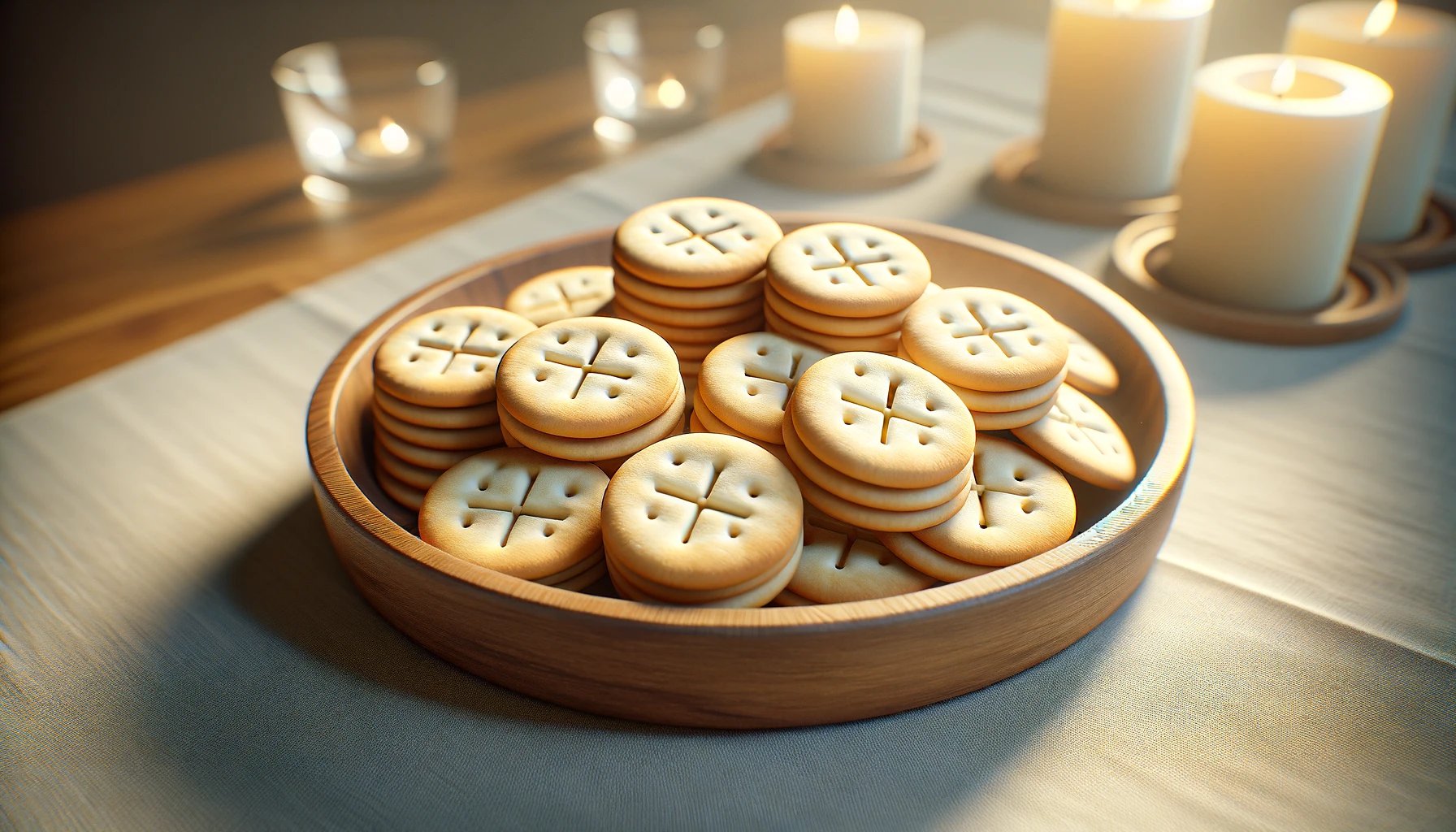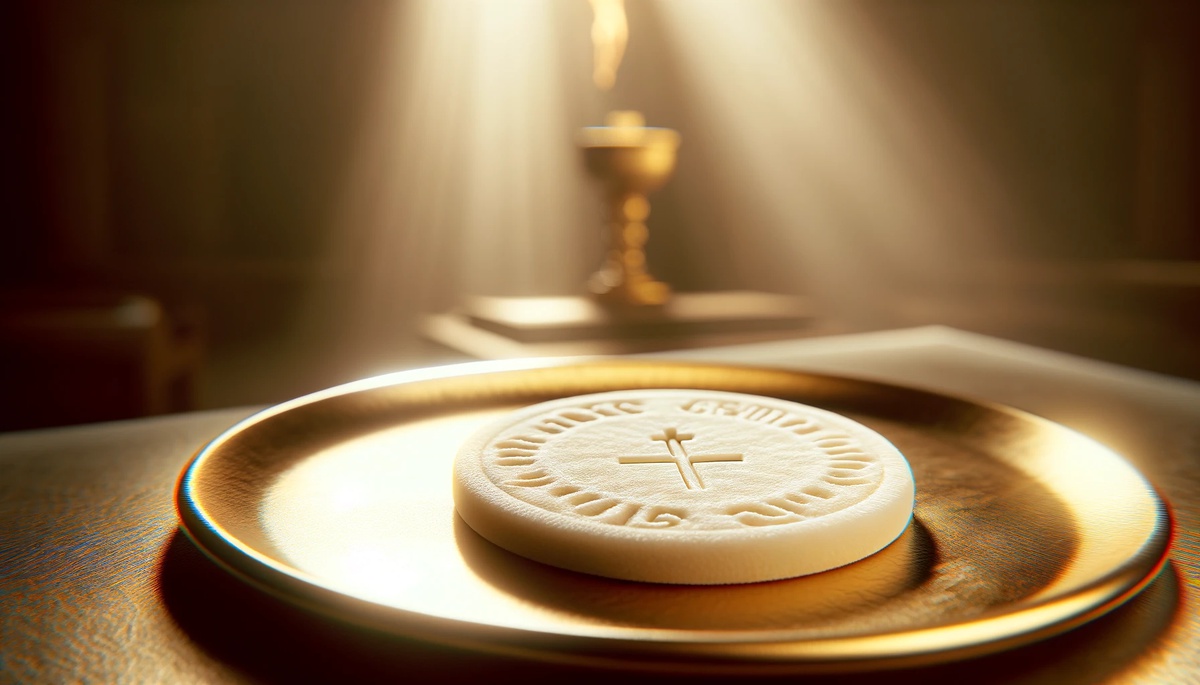Home>Theology and Spirituality>What Kind Of Crackers Can Be Used For Communion


Theology and Spirituality
What Kind Of Crackers Can Be Used For Communion
Published: February 25, 2024
Jason DeRose, Managing Editor at Christian.net, uses his expertise in religion and journalism to deepen understanding of faith's societal impacts. His editorial leadership, coupled with a strong academic background, enriches the platform’s diverse content, earning him recognition in both journalism and religious circles.
Discover the best crackers for Communion and explore their significance in theology and spirituality. Learn about the different types and their role in religious practices.
(Many of the links in this article redirect to a specific reviewed product. Your purchase of these products through affiliate links helps to generate commission for Christian.net, at no extra cost. Learn more)
Table of Contents
Introduction
Communion, also known as the Eucharist or the Lord's Supper, holds significant spiritual and symbolic importance in various Christian traditions. This sacred ritual involves the consumption of bread and wine, symbolizing the body and blood of Jesus Christ, and is a central part of Christian worship services. While the theological significance of communion is paramount, the practical elements, such as the type of bread or crackers used, also play a crucial role in the observance of this sacrament.
The choice of communion crackers may seem like a trivial matter, but it holds deeper implications for the individuals partaking in the ritual. The type of cracker used can impact the experience of communion for congregants, especially those with dietary restrictions or allergies. Additionally, the selection of communion crackers can reflect the values and inclusivity of a religious community, making it an important decision for church leaders and members alike.
In this article, we will explore the significance of choosing the right crackers for communion, including traditional options and considerations for accommodating individuals with dietary restrictions. By understanding the importance of this choice and exploring the available options, churches and religious communities can ensure that the observance of communion is meaningful and accessible to all who wish to participate.
Read more: 75 Important Bible Verses About Kindness
Importance of Choosing the Right Crackers for Communion
The selection of communion crackers holds profound significance within the context of the sacred ritual of communion. While the theological and spiritual aspects of communion are paramount, the practical elements, such as the choice of crackers, play a crucial role in the overall experience of this sacrament.
First and foremost, the choice of communion crackers can profoundly impact the inclusivity and accessibility of the communion experience. By selecting crackers that accommodate various dietary needs, religious communities can ensure that all individuals, regardless of their dietary restrictions or allergies, can fully participate in the ritual. This inclusivity aligns with the core principles of many religious traditions, emphasizing the welcoming and acceptance of all individuals, regardless of their circumstances.
Furthermore, the type of crackers chosen for communion can also influence the sensory experience of the ritual. The texture, taste, and quality of the crackers can contribute to the overall atmosphere and reverence of the communion service. Whether the crackers are unleavened or slightly leavened, their appearance and taste can enhance the symbolic nature of the ritual, deepening the spiritual connection for those partaking in the sacrament.
Moreover, the selection of communion crackers can serve as a reflection of a religious community's commitment to mindful and intentional practices. By carefully choosing crackers that align with the values of simplicity, purity, and inclusivity, churches and religious organizations can demonstrate their dedication to upholding the sacredness of the communion ritual while embracing the diversity of their congregants.
In essence, the importance of choosing the right crackers for communion extends beyond mere practicality; it encompasses the fundamental principles of inclusivity, reverence, and intentionality within the context of religious worship. By recognizing the significance of this choice, religious leaders and communities can ensure that the observance of communion remains a meaningful and accessible experience for all participants, fostering a sense of unity and spiritual connection among congregants.
Traditional Options for Communion Crackers
When considering traditional options for communion crackers, one of the most prevalent choices is unleavened bread. Unleavened bread, often in the form of small, thin wafers, holds historical and symbolic significance within Christian traditions. Its unleavened nature harkens back to the biblical accounts of the Last Supper, where Jesus shared bread with his disciples, symbolizing his body that would be broken for the salvation of humanity. The simplicity and purity of unleavened bread align with the solemnity and reverence of the communion ritual, emphasizing the unadorned nature of the sacrament.
In addition to unleavened bread, some Christian denominations may use slightly leavened bread for communion. This variation, while less common in certain traditions, reflects the diversity of practices within Christianity. The use of slightly leavened bread can symbolize the living nature of Christ and the spiritual growth of believers. While maintaining the essential symbolism of Christ's body, the inclusion of a minimal leavening agent represents the ongoing transformation and renewal experienced by individuals through their faith.
Another traditional option for communion crackers is the use of matzo, a type of unleavened flatbread with Jewish origins. Matzo holds historical significance in the Jewish Passover tradition and has been adopted by some Christian denominations for communion. Its crisp texture and simple composition make it a fitting choice for the solemn observance of the Eucharist.
Furthermore, some churches may opt for homemade unleavened bread, prepared by members of the congregation as a communal and reverent practice. This approach not only emphasizes the communal aspect of the communion ritual but also allows for a more personalized and intentional preparation of the bread, further enhancing the spiritual significance of the sacrament.
Overall, the traditional options for communion crackers encompass a range of symbolic and practical considerations, each carrying its own historical and theological significance. Whether through the use of unleavened wafers, slightly leavened bread, matzo, or homemade creations, these traditional choices contribute to the rich tapestry of communion practices within diverse Christian traditions, underscoring the enduring importance of this sacred ritual in the life of the faithful.
Gluten-Free and Allergen-Friendly Options for Communion
In recent years, there has been a growing awareness of the diverse dietary needs and food allergies present within congregations, prompting religious communities to seek inclusive communion practices that accommodate individuals with gluten sensitivities, celiac disease, and other allergens. Recognizing the importance of ensuring that all members can participate fully in the sacrament of communion, churches have increasingly turned their attention to gluten-free and allergen-friendly options for communion.
One prevalent alternative for individuals with gluten sensitivities is the use of gluten-free communion wafers. These specially formulated wafers are crafted to mirror the appearance and texture of traditional unleavened bread while being entirely free of gluten. By offering gluten-free communion wafers, churches can extend a welcoming invitation to individuals who would otherwise be unable to partake in the ritual due to gluten-related dietary restrictions.
Moreover, some religious communities have embraced the practice of using rice-based communion wafers as a gluten-free alternative. These wafers, made from rice flour, provide a suitable option for individuals with gluten sensitivities while upholding the essential symbolism and reverence of the communion ritual. The adoption of rice-based communion wafers reflects a commitment to inclusivity and ensures that all members, regardless of their dietary needs, can participate in the sacred observance of communion.
In addition to gluten-free considerations, churches have also explored allergen-friendly options for communion to accommodate individuals with various food allergies. This may involve sourcing communion elements that are free from common allergens such as nuts, dairy, soy, or other potential triggers for allergic reactions. By prioritizing allergen-friendly communion elements, religious communities demonstrate a deep commitment to creating a safe and inclusive environment for all worshippers, allowing them to partake in communion without concerns about allergic reactions.
Furthermore, some churches have taken proactive measures to communicate and educate their congregations about the ingredients used in communion elements, enabling individuals to make informed choices based on their dietary needs and allergies. This transparency fosters a sense of understanding and support within the community, empowering individuals to participate in communion with confidence and peace of mind.
In essence, the exploration of gluten-free and allergen-friendly options for communion reflects a compassionate and inclusive approach to religious practice. By embracing these alternatives, churches demonstrate a commitment to honoring the diverse needs of their members while upholding the sacred tradition of communion. This intentional inclusivity fosters a sense of belonging and unity within the congregation, ensuring that all individuals can partake in the spiritual significance of the Eucharist without limitations or barriers.
Considerations for Choosing the Best Crackers for Communion
When selecting the best crackers for communion, several important considerations come into play to ensure that the observance of this sacred ritual is meaningful, inclusive, and reverent. These considerations encompass both practical and symbolic elements, reflecting the values and priorities of religious communities as they prepare for the Eucharist.
First and foremost, inclusivity stands as a paramount consideration in choosing communion crackers. Religious leaders and communities strive to ensure that all individuals, regardless of their dietary restrictions, allergies, or sensitivities, can fully participate in the communion ritual. This commitment to inclusivity may involve offering gluten-free communion wafers or allergen-friendly options, allowing every member of the congregation to partake in the sacrament without limitations or exclusions.
Additionally, the symbolic significance of the crackers cannot be overlooked. The chosen crackers should align with the theological and historical traditions of the specific religious denomination, reflecting the solemnity and reverence of the communion ritual. Whether opting for unleavened wafers, slightly leavened bread, or other traditional choices, the symbolic representation of Christ's body remains central to the selection process, ensuring that the crackers embody the sacred nature of the Eucharist.
Furthermore, the quality and integrity of the crackers play a vital role in the overall communion experience. Churches and religious organizations prioritize the use of high-quality, well-prepared crackers that uphold the dignity and sanctity of the ritual. Whether sourced from trusted suppliers or prepared within the faith community, the crackers should reflect a level of care and intentionality that honors the spiritual significance of the communion service.
Moreover, practical considerations, such as the ease of distribution and consumption, also factor into the selection of communion crackers. The size, texture, and handling of the crackers should facilitate a seamless and reverent distribution during the communion service, allowing congregants to partake in the ritual with grace and solemnity.
Ultimately, the considerations for choosing the best crackers for communion encompass a harmonious blend of inclusivity, symbolism, quality, and practicality. By carefully evaluating these factors, religious communities can ensure that the observance of communion remains a deeply meaningful and accessible experience for all participants, fostering a sense of unity and spiritual connection within the congregation.
Read more: What Is Close Communion
Conclusion
In conclusion, the choice of crackers for communion holds profound significance within the sacred ritual of the Eucharist. The observance of communion represents a deeply spiritual and communal experience, and the selection of the appropriate crackers plays a pivotal role in ensuring that the ritual remains inclusive, reverent, and meaningful for all participants.
The traditional options for communion crackers, including unleavened bread, slightly leavened bread, matzo, and homemade creations, reflect the rich tapestry of communion practices within diverse Christian traditions. These choices carry historical and theological significance, underscoring the enduring importance of this sacred ritual in the life of the faithful.
Furthermore, the exploration of gluten-free and allergen-friendly options for communion exemplifies a compassionate and inclusive approach to religious practice. By embracing these alternatives, churches demonstrate a commitment to honoring the diverse needs of their members while upholding the sacred tradition of communion. This intentional inclusivity fosters a sense of belonging and unity within the congregation, ensuring that all individuals can partake in the spiritual significance of the Eucharist without limitations or barriers.
When choosing the best crackers for communion, considerations encompass inclusivity, symbolism, quality, and practicality. By carefully evaluating these factors, religious communities can ensure that the observance of communion remains a deeply meaningful and accessible experience for all participants, fostering a sense of unity and spiritual connection within the congregation.
Ultimately, the significance of choosing the right crackers for communion extends beyond mere practicality; it encompasses the fundamental principles of inclusivity, reverence, and intentionality within the context of religious worship. By recognizing the importance of this choice, religious leaders and communities can ensure that the observance of communion remains a meaningful and accessible experience for all participants, fostering a sense of unity and spiritual connection among congregants.














